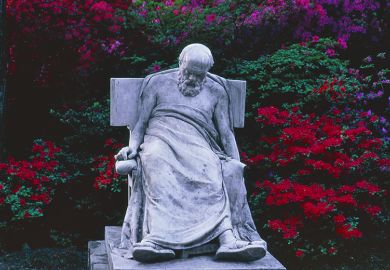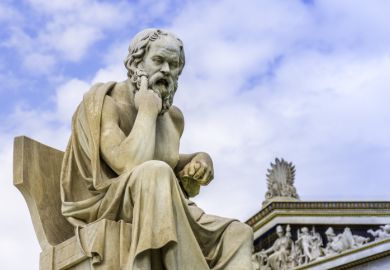A penny for your thoughts. It is a common feature of mental acts that they are about something, but what is the relation between the thinking mind and the "something'' it is thinking about? This is the puzzle of "intentionality'' and it is one of the toughest problems in the philosophy of mind.
The modern use of this technical term which has medieval roots and should not be confused with our everyday use of "intentional'' as equivalent to "deliberate" goes back to Franz Brentano over a century ago. He held that being "about something'' other than itself was the defining characteristic of the mental in contrast to the physical. It follows from this that intentional states such as believing and desiring - indeed all conscious states - are incapable of being reduced to a purely physical description. Although his terminology has stuck, the tide is running against his views (but not as completely as William Lyons implies in this book by relegating the work of his successors to a footnote reference). All the approaches discussed aim for a physical or biological theory of intentionality.
This detracts from the balance of an otherwise attractive introduction to a complex subject. Lyons's target audience is students and fellow scholars, and this is no light read. But the general reader with an interest in the philosophy of mind will find here a sympathetic guide to some major players in the field. Jargon is explained, and there are plenty of headed sections to break up the text and signpost the discussion.
As I sit writing this, dark clouds are gathering and the wind is getting up. I expect it to start raining shortly. How does this expectation arise? Is the concept of imminent rain somehow lodged in the physical structure or processes of my brain? Many would answer "yes". Jerry Fodor, for example, says that if I believe it is about to rain, then my head literally contains the proposition "It is about to rain'' encoded in the brain's innate language of thought. (Fodor goes beyond Chomsky here, in positing a brain-language rather than just a capacity for language.) Compared with some of his philosophical colleagues, Fodor sees himself as a defender of common-sense "folkpsychology'', which assumes that our thoughts are literally there. But he remains an out-and-out physicalist, reducing the whole of our mental acts to states or processes of the brain without remainder - and that is not how we commonly think of ourselves.
Fred Dretske champions an "information-processing'' account of intentionality. Like Fodor, Dretske says that there is in the brain an internal representation of external affairs, but he does not imagine it linguistically. He sees it arising from perceptual information that has to be transformed from its diffuse "analogue'' form to a precise "digital'' form before it can yield any meaning (contents). Even then the processing is not complete, because the use to which these contents are put (their functional role) determines whether they become beliefs ("It will rain") or desires ("I hope it holds off until I have walked the dog").
Function is central for Ruth Garrett Millikan's "teleological'' account. She emphasises that intentionality is as much a part of our biology as our limbs and organs, and says we need to look to the effects a device is designed to have to understand its proper function. In the case of a belief system, the desired effect is an accurate representation of the world to enhance the possessor's chances of survival. Therefore, despite some obvious errors, the content of our beliefs must be fundamentally reliable, or the system would not have been selected evolutionally. For my money, this section is the weakest part of Lyons's book. His delineation of the approach, and his criticisms of it, fall short of his usual high standard. In particular, he allows loose talk of "design'' that does not make clear who is the alleged designer.
Standing out from the crowd as always is Daniel Dennett, whose swashbuckling "instrumentalist'' approach dispatches intentionality by the simple if drastic expedient of denying its existence. Dennett admits that "people really do have beliefs and desires'', but only in the same sense that they really have centres of gravity and the earth has an equator. All these things are nothing more and nothing less than useful fictions that help us to accomplish some practical task. In the case of beliefs and desires, we attribute them to ourselves and to others as an effective short-hand way of predicting behaviour. But they do not really exist: not in the mind, because the "mind'' is also, in Dennett's opinion, a fictional creation; and not in the brain, because for him neither states nor processes of the brain have contents.
Having discussed these and other approaches to intentionality, Lyons finally puts forward his own theory. He sums up the basic problem like this: how do we know that our sensory experiences come from the world outside and are reliable guides for making our way in that world? Traditional answers fall into two categories: the nativist view that we are born with an innate concept of objectivity or "outsideness"; and the empiricist claim that we require such a concept along with our first sensory experiences. Lyons rejects both. They treat intentionality as "just one thing'' of which it can be asked "Is it here or is it there?'' This "Scarlet Pimpernel question'' is a mistake. Intentionality is to be found in a number of places, though in a different form in each place.
There are, Lyons suggests, four layers of intentionality: brain-level, sensory, linguistic, and that attributable to whole persons. His theory has similarities to Dretske's information-processing model, but differs in that Lyons insists that the brain as such does not interpret or understand the information it processes. It is not the brain but the whole person who has a belief or desire or other "propositional attitude''. This is the deepest sort of intentionality and, while it depends on brain processes, language and so on, it cannot be reduced to any of these. At this level, argues Lyons with some persuasiveness, "folkpsychology'' is a highly sophisticated theory, and the best one available.
Revd. Anthony Freeman is managing editor, Journal of Consciousness Studies.
Approaches to Intentionality
Author - William Lyons
ISBN - 0 19 823526 7
Publisher - Clarendon Press, Oxford
Price - £30.00
Pages - 261
Register to continue
Why register?
- Registration is free and only takes a moment
- Once registered, you can read 3 articles a month
- Sign up for our newsletter
Subscribe
Or subscribe for unlimited access to:
- Unlimited access to news, views, insights & reviews
- Digital editions
- Digital access to THE’s university and college rankings analysis
Already registered or a current subscriber?



